The Die Cast Toys Market is estimated to be valued at USD 4.1 billion in 2025 and is projected to reach USD 6.2 billion by 2035, registering a compound annual growth rate (CAGR) of 4.3% over the forecast period. The die cast toys market is projected to generate an absolute gain of USD 2.1 billion and a growth multiplier of 1.51x over the decade. Supported by a steady CAGR of 4.3%, this growth is driven by increasing consumer demand for collectible and high-quality die-cast toy models, especially in niche markets.
During the first five years (2025 to 2030), the market is expected to expand from USD 4.1 billion to USD 5.0 billion, adding USD 0.9 billion, which accounts for 42.9% of the total incremental growth, with a 5-year multiplier of 1.22x. The second phase (2030 to 2035) contributes USD 1.2 billion, representing 57.1% of incremental growth, reflecting stronger growth driven by increasing interest in limited-edition, licensed, and branded die-cast models.
Annual increments rise from USD 0.2 billion in early years to USD 0.3 billion by 2035, indicating increased consumer spending and the expansion of the product's appeal across generations. Manufacturers focusing on nostalgia-driven collections, licensed partnerships, and product diversification will capture the largest share of this USD 2.1 billion opportunity.
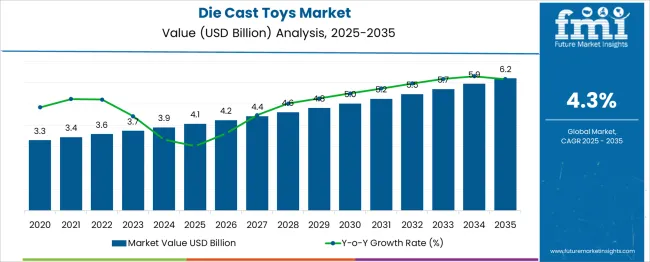
| Metric | Value |
|---|---|
| Die Cast Toys Market Estimated Value in (2025 E) | USD 4.1 billion |
| Die Cast Toys Market Forecast Value in (2035 F) | USD 6.2 billion |
| Forecast CAGR (2025 to 2035) | 4.3% |
The Die Cast Toys market is gaining significant momentum, driven by increasing demand for collectible and durable toys among both children and adult hobbyists. Growth has been influenced by the appeal of realistic replicas, advancements in miniature design, and rising interest in nostalgia-driven consumer preferences. Manufacturers are focusing on precision detailing and expanding product lines that cater to pop culture, motorsports, and historical themes.
As premiumization and licensing partnerships continue to evolve, the market is benefiting from enhanced brand collaborations and limited edition releases. The rising global popularity of scale model displays and hobbyist communities has also contributed to increased sales.
Further growth is being supported by improvements in material quality, power integration for interactive play, and eco-conscious production methods. With expanding retail channels and digital marketing strategies targeting collectors and parents alike, the market outlook remains strong, particularly across North America, Europe, and parts of Asia Pacific..
The die cast toys market is segmented by product type, material, power source, price, scale, end-use, control method, and geographic regions. By product type, the die cast toys market is divided into Cars & trucks, Motorcycles & bikes, Airplanes, and Trains. In terms of material, the die cast toys market is classified into Metal, Aluminum, Plastic, and Rubber. The die cast toys market is segmented into Battery power and wind power.
The price of the die cast toys market is segmented into Medium, Low, and High. The scale of the die cast toys market is segmented into 1:24–1:43, 1:8–1:18, 1:43–1:761:87–3'. The end use of the die cast toys market is segmented into Individual consumers and educational institutions. The control method of the die cast toys market is segmented into Manual, Remote, and Interactive. Regionally, the die cast toys industry is classified into North America, Latin America, Western Europe, Eastern Europe, Balkan & Baltic Countries, Russia & Belarus, Central Asia, East Asia, South Asia & Pacific, and the Middle East & Africa.
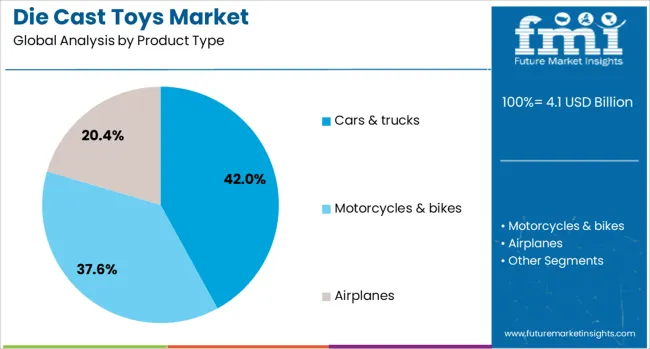
The cars and trucks product type segment is projected to hold 42% of the Die Cast Toys market revenue share in 2025, making it the leading category. This dominance has been attributed to their widespread popularity among collectors and children alike, due to the high level of detail, realism, and emotional connection associated with automotive toys. The segment has benefited from long-standing brand associations, often aligned with real-world vehicle manufacturers, which have enhanced authenticity and appeal.
The inclusion of moving parts and realistic paint finishes has further elevated the perceived value of cars and trucks within the die cast category. Collectability, particularly for limited or special editions, has remained a strong driver of sales.
The broader cultural fascination with vehicles, motorsport, and transport history has also supported this segment. As manufacturers continue to innovate with themed releases and collaborate with entertainment franchises, the cars and trucks segment is expected to retain its leadership in the product type category..
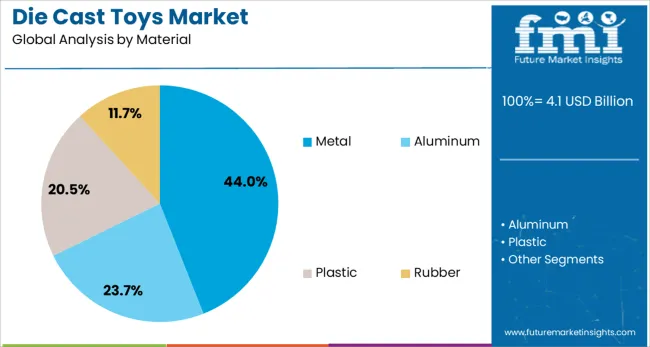
The metal material segment is expected to account for 44% of the Die Cast Toys market revenue share in 2025, positioning it as the leading material type. The growth of this segment has been driven by the durability, tactile appeal, and premium feel associated with metal-based toys. Metal construction has allowed for greater detailing, improved weight distribution, and an enhanced sense of realism, which are all critical to both collectors and young users.
Compared to plastic alternatives, metal die cast models have offered increased longevity and better resistance to wear and damage. The perception of metal toys as quality-oriented and collectible has also reinforced their preference for higher-value product lines.
Manufacturing improvements and cost-effective alloy compositions have enabled brands to scale production without compromising on quality. As sustainability concerns rise, metal materials are being viewed more favorably due to their recyclability and reduced dependence on petroleum-based components, further supporting this segment’s continued leadership..
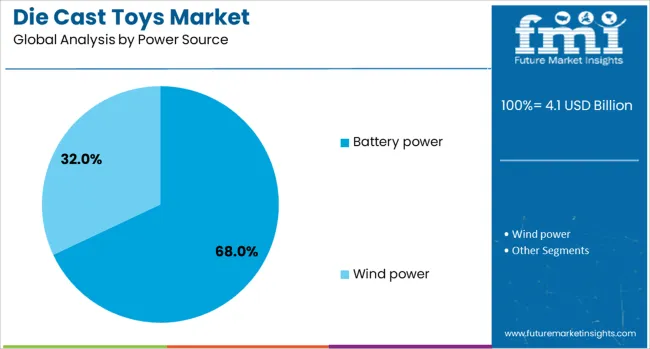
The battery power segment is projected to command 68% of the die cast toys market revenue share in 2025, emerging as the leading power source. This growth has been primarily driven by rising demand for interactive and motion-enabled toys that offer enhanced play value through lights, sounds, and movement. Battery-operated die cast toys have become increasingly popular due to their ability to combine traditional craftsmanship with modern functionality, appealing to both children and collectors seeking dynamic experiences.
Advances in compact battery technology and safe electrical integration have enabled manufacturers to embed power features without compromising design aesthetics. As consumer expectations evolve toward multi-sensory engagement, battery-powered toys are being positioned as the next generation of collectible and play-oriented models.
The ability to refresh play patterns, enhance storytelling, and create more immersive environments has made battery-powered toys a preferred choice in the die cast category. This segment’s performance continues to be supported by innovations in battery life, modularity, and integration with digital ecosystems..
The die cast toys market is growing, driven by rising demand from collectors and children. Growth drivers include the increasing interest in collectible toys and nostalgia-driven purchases. Opportunities are seen in collaborations with popular entertainment franchises. Emerging trends focus on premium quality and limited-edition toys. However, market restraints include high production costs and competition from plastic-based toys, limiting broader adoption in some regions. The market remains competitive, with evolving consumer preferences and pricing strategies shaping the landscape.
The major growth driver in the die-cast toys market is the rising demand for collectible and nostalgia-driven toys. In 2024, collectors and adult consumers fueled the market, especially for high-quality die-cast models. The growing trend of nostalgia led to an increase in sales of classic toy models, with manufacturers focusing on creating limited editions and exclusive designs. This shift helped the die-cast toys market expand significantly during the period.
Opportunities in the die-cast toys market are found in collaborations with popular entertainment franchises. In 2025, partnerships between die-cast toy manufacturers and movie franchises such as Marvel and Fast & Furious gained momentum. This collaboration brought exclusive and themed products to the market, attracting a broader consumer base. These partnerships provided manufacturers with the chance to tap into new fan groups, driving sales and increasing brand visibility across various age demographics.
Emerging trends in the die-cast toys market include the growing demand for premium quality and limited-edition products. In 2024, manufacturers focused on producing highly detailed models with superior craftsmanship, appealing to adult collectors and enthusiasts. Limited-edition releases and special collaborations further fueled this trend, creating exclusive products that commanded higher price points. This shift towards premium offerings is expected to define the market in the coming years, catering to an evolving, niche consumer base.
Major market restraints in the die-cast toys market include high production costs and stiff competition from plastic-based toys. In 2025, manufacturers faced challenges in balancing production costs for die-cast toys with consumer price sensitivity. The expense involved in crafting high-quality die-cast models made it difficult to compete with cheaper plastic alternatives, especially in price-sensitive regions. This restraint may limit market expansion, particularly in emerging economies where cost-effective options are preferred.
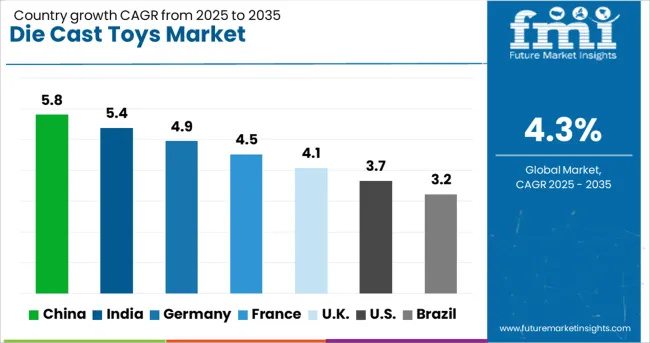
| Country | CAGR |
|---|---|
| China | 5.8% |
| India | 5.4% |
| Germany | 4.9% |
| France | 4.5% |
| UK | 4.1% |
| USA | 3.7% |
| Brazil | 3.2% |
The global die cast toys market is projected to grow at a CAGR of 4.3% from 2025 to 2035. China leads with a growth rate of 5.8%, followed by India at 5.4%, and Germany at 4.9%. The United Kingdom records a growth rate of 4.1%, while the United States shows the slowest growth at 3.7%. These variations in growth are influenced by factors such as consumer preferences, disposable incomes, and the level of industrial production. Emerging markets like China and India are witnessing higher demand due to increasing disposable income and rising demand for high-quality, collectible toys. On the other hand, mature markets like the USA and the UK exhibit slower growth due to market saturation and established consumer bases.
The die cast toys market in China is growing at a robust 5.8% CAGR. The rapid expansion of the country’s manufacturing sector and rising disposable income are key drivers behind this growth. As more consumers in China seek collectible and high-quality die cast toys, manufacturers are increasingly focusing on offering a wider variety of products. Additionally, the popularity of die cast toys as gifts and collectibles, coupled with China’s strong export market, continues to fuel the demand. The rising interest in online shopping platforms further contributes to the market’s expansion.
The die cast toys market in India is expected to grow at a CAGR of 5.4%. As the country’s economy continues to expand, more consumers are purchasing high-quality die cast toys. India’s growing middle class, along with increasing disposable incomes, is contributing to this demand. The market for die cast toys is also being driven by rising popularity among children and collectors, with a shift toward premium and branded toy products. The increasing availability of die cast toys in retail and online markets further supports the sector’s growth.
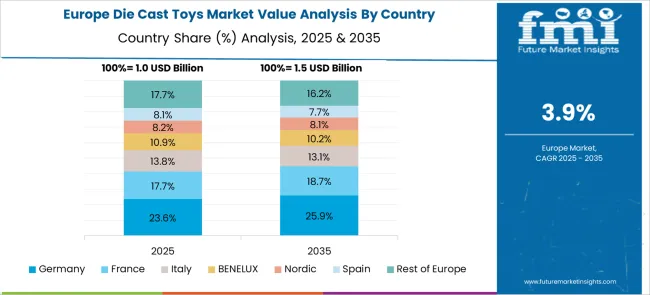
The die cast toys market in Germany is projected to grow at a CAGR of 4.9%. As one of the leading markets in Europe, Germany sees steady demand for high-quality die cast toys, particularly from collectors and enthusiasts. The country's strong consumer preference for durable and detailed toys, along with a robust retail infrastructure, supports market growth. Additionally, the popularity of die cast toys as a hobby and collectibles segment continues to drive demand. The market is also benefitting from the growing trend of sustainable and eco-friendly toy production.
The die cast toys market in the United Kingdom is projected to grow at a CAGR of 4.1%. The demand for die cast toys in the UK is largely driven by both children and adult collectors, with a growing emphasis on nostalgia-driven toy purchases. The market’s growth is supported by strong retail distribution channels and the increasing availability of die cast toys through online platforms. Additionally, as consumers continue to prioritize high-quality and detailed toys, manufacturers are innovating to meet the demand for premium die cast products.
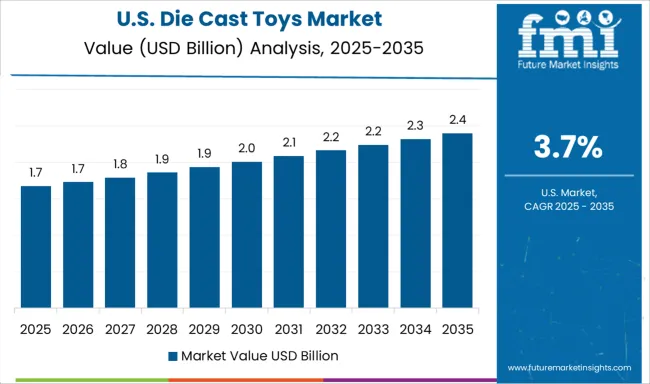
The die cast toys market in the United States is expected to grow at a CAGR of 3.7%. While the market is mature, the USA continues to see steady demand driven by both collectors and children. The rise of collectible toy trends and nostalgia for vintage die cast models contributes to consistent demand. Despite market saturation, innovation in die cast toy designs and the growing preference for high-quality, branded products are helping maintain consumer interest. Additionally, the strong presence of online retail platforms facilitates access to a broader audience.
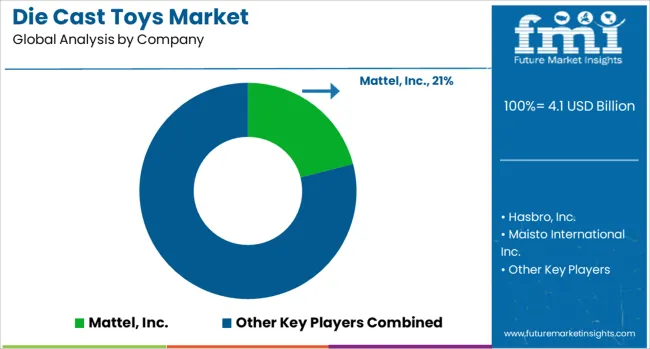
The die-cast toys market is dominated by Mattel, Inc., which leads with its extensive portfolio of die-cast toy vehicles, including the iconic Hot Wheels series. Mattel’s dominance is supported by its global brand recognition, innovation in toy design, and strong relationships with retailers. Key players such as Hasbro, Inc., Maisto International Inc., and Spin Master Ltd. maintain significant market shares by offering a wide range of die-cast toy vehicles, including action figures, vehicles, and playsets, designed for both collectible and recreational purposes.
These companies focus on delivering high-quality, durable toys that appeal to both children and adult collectors, with a strong emphasis on brand loyalty and product variety. Emerging players like NewRay Toys Company and GreenLight Collectibles are expanding their market presence by offering specialized die-cast models and limited-edition collections aimed at collectors and hobbyists.
Their strategies focus on offering realistic, highly detailed toys, including classic cars, military vehicles, and racing cars, catering to niche market segments. Market growth is driven by the increasing popularity of collectible toys, growing demand for quality playsets, and the rise of nostalgia among adult collectors. Innovations in design, materials, and collaborations with brands and franchises are expected to shape competitive dynamics and foster continued expansion in the global die-cast toys market.
| Item | Value |
|---|---|
| Quantitative Units | USD 4.1 Billion |
| Product Type | Cars & trucks, Motorcycles & bikes, Airplanes, and Trains |
| Material | Metal, Aluminum, Plastic, and Rubber |
| Power Source | Battery power and Wind power |
| Price | Medium, Low, and High |
| Scale | 1:24–1:43, 1:8–1:18, 1:43–1:76, and 1:87–3' |
| End Use | Individual consumers and Educational institutions |
| Control Method | Manual, Remote, and Interactive |
| Regions Covered | North America, Europe, Asia-Pacific, Latin America, Middle East & Africa |
| Country Covered | United States, Canada, Germany, France, United Kingdom, China, Japan, India, Brazil, South Africa |
| Key Companies Profiled | Mattel, Inc., Hasbro, Inc., Maisto International Inc., NewRay Toys Company, Spin Master Ltd., GreenLight Collectibles, and Others |
| Additional Attributes | Dollar sales by toy type and material, demand dynamics across collectors, children’s toys, and educational markets, regional trends in die-cast toy production and consumption, innovation in design and paint technologies, impact of regulatory standards on toy safety, and emerging use cases in nostalgic collections and interactive toys. |
The global die cast toys market is estimated to be valued at USD 4.1 billion in 2025.
The market size for the die cast toys market is projected to reach USD 6.2 billion by 2035.
The die cast toys market is expected to grow at a 4.3% CAGR between 2025 and 2035.
The key product types in die cast toys market are cars & trucks, _sports, _super, _road, _pickup trucks, _lorries, _other (vintage, construction), motorcycles & bikes, _sports bikes, _chopper bikes, _dirt bikes, _cruiser bikes, airplanes, _commercial jets, _military aircraft, _helicopters, trains, _locomotives, _passenger cars and _freight cars.
In terms of material, metal segment to command 44.0% share in the die cast toys market in 2025.






Our Research Products

The "Full Research Suite" delivers actionable market intel, deep dives on markets or technologies, so clients act faster, cut risk, and unlock growth.

The Leaderboard benchmarks and ranks top vendors, classifying them as Established Leaders, Leading Challengers, or Disruptors & Challengers.

Locates where complements amplify value and substitutes erode it, forecasting net impact by horizon

We deliver granular, decision-grade intel: market sizing, 5-year forecasts, pricing, adoption, usage, revenue, and operational KPIs—plus competitor tracking, regulation, and value chains—across 60 countries broadly.

Spot the shifts before they hit your P&L. We track inflection points, adoption curves, pricing moves, and ecosystem plays to show where demand is heading, why it is changing, and what to do next across high-growth markets and disruptive tech

Real-time reads of user behavior. We track shifting priorities, perceptions of today’s and next-gen services, and provider experience, then pace how fast tech moves from trial to adoption, blending buyer, consumer, and channel inputs with social signals (#WhySwitch, #UX).

Partner with our analyst team to build a custom report designed around your business priorities. From analysing market trends to assessing competitors or crafting bespoke datasets, we tailor insights to your needs.
Supplier Intelligence
Discovery & Profiling
Capacity & Footprint
Performance & Risk
Compliance & Governance
Commercial Readiness
Who Supplies Whom
Scorecards & Shortlists
Playbooks & Docs
Category Intelligence
Definition & Scope
Demand & Use Cases
Cost Drivers
Market Structure
Supply Chain Map
Trade & Policy
Operating Norms
Deliverables
Buyer Intelligence
Account Basics
Spend & Scope
Procurement Model
Vendor Requirements
Terms & Policies
Entry Strategy
Pain Points & Triggers
Outputs
Pricing Analysis
Benchmarks
Trends
Should-Cost
Indexation
Landed Cost
Commercial Terms
Deliverables
Brand Analysis
Positioning & Value Prop
Share & Presence
Customer Evidence
Go-to-Market
Digital & Reputation
Compliance & Trust
KPIs & Gaps
Outputs
Full Research Suite comprises of:
Market outlook & trends analysis
Interviews & case studies
Strategic recommendations
Vendor profiles & capabilities analysis
5-year forecasts
8 regions and 60+ country-level data splits
Market segment data splits
12 months of continuous data updates
DELIVERED AS:
PDF EXCEL ONLINE
Diesel Parking Heater Market Size and Share Forecast Outlook 2025 to 2035
Diesel Power Engine Market Size and Share Forecast Outlook 2025 to 2035
Die Cut Support Pads Market Size and Share Forecast Outlook 2025 to 2035
Diethyl Sulfate Market Size and Share Forecast Outlook 2025 to 2035
Diesel Particulate Filter Market Size and Share Forecast Outlook 2025 to 2035
Diesel Mobile Light Tower Market Size and Share Forecast Outlook 2025 to 2035
Diesel Powered Portable Conventional Gensets Market Size and Share Forecast Outlook 2025 to 2035
Diesel Light Tower Market Size and Share Forecast Outlook 2025 to 2035
Diesel Electric Powered Hybrid Marine Gensets Market Size and Share Forecast Outlook 2025 to 2035
Diesel Powered Real Estate Generator Market Size and Share Forecast Outlook 2025 to 2035
Dietary Fiber Gummies Market Size and Share Forecast Outlook 2025 to 2035
Diesel-Fired Portable Inverter Generator Market Size and Share Forecast Outlook 2025 to 2035
Diesel Fired Telecom Generator Market Size and Share Forecast Outlook 2025 to 2035
Diesel-Fired Construction Generator Sets Market Size and Share Forecast Outlook 2025 to 2035
Dietary Supplement Market Insights - Growth & Demand 2025 to 2035
Diesel Fueled Air Cooled Home Standby Gensets Market Size and Share Forecast Outlook 2025 to 2035
Diesel Prime Power Generators Market Size and Share Forecast Outlook 2025 to 2035
Dietary Fiber Market Analysis - Size, Share, and Forecast Outlook 2025 to 2035
Die Cut Display Container Market Size and Share Forecast Outlook 2025 to 2035
Die Cart Market Analysis - Size, Share, and Forecast Outlook 2025 to 2035

Thank you!
You will receive an email from our Business Development Manager. Please be sure to check your SPAM/JUNK folder too.
Chat With
MaRIA